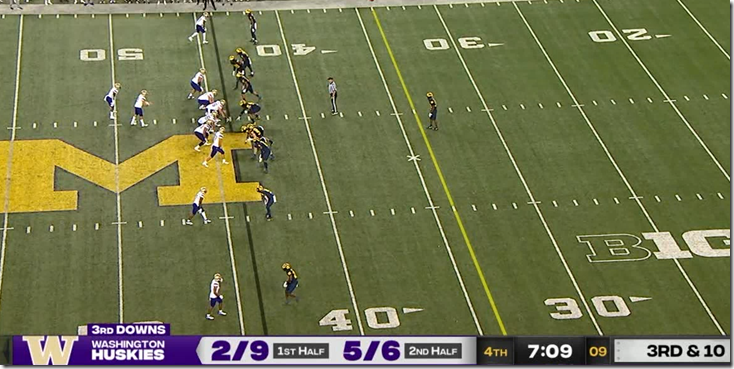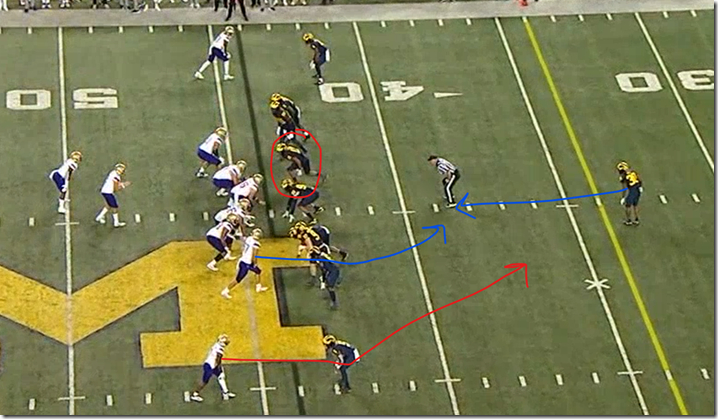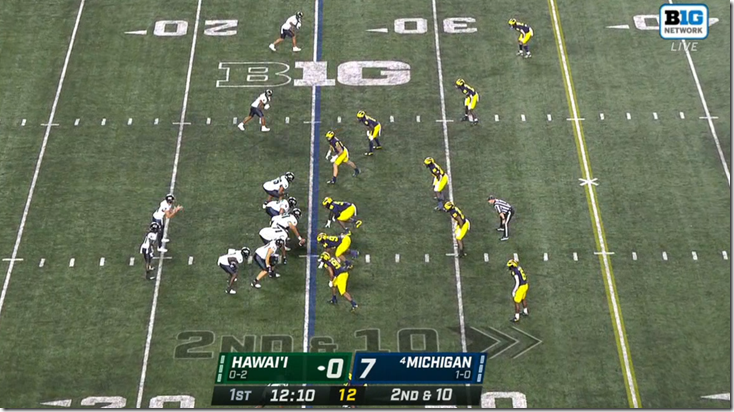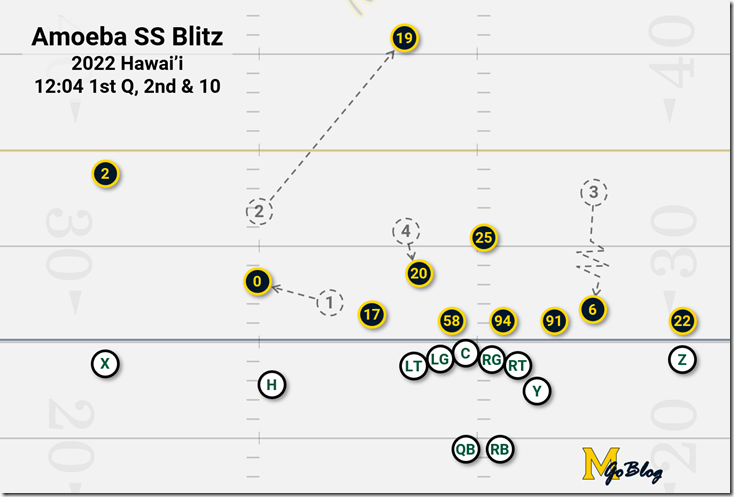
Neck Sharpies: Amoeba Deployed

Ever since Mike Macdonald arrived, and continuing into Jesse Minter, I've been throwing around the term "Amoeba Defense" in reference to Michigan's disguised fronts and coverages. I probably should get into what that means, and how they're using it. The concept is actually a suite of ideas that are old and ubiquitous at all levels of football:
- Hybrid defenders.
- Zone blitzes.
- Pre-snap motion.
This is not original. It's the thing Jerry Sandusky was most known for before the other thing. It's what Dick LeBeau made his Hall of Fame career on. It's what Michigan ran as its base defense the last time we imported a Ravens defensive assistant in 2011-'12. Bob Davie is credited with coming up with it when trying to counter the Run 'n Shoot. Even without the talent disparity, the Amoeba's origins made it particularly well-suited to combat an Air Raid run by Hal Mumme's son in Game 1, let alone a Run 'n Shoot coached by a June Jones quarterback (who until last year was coaching under Hal Mumme's son) in Game 2.
It has been my assertion that Michigan dipped its toes in Amoeba world last year, then shelved it for two reasons:
- David Ojabo emerged as an elite old-school pass-rusher, which is still the best way to get pressure if you can find it.
- Vincent Gray and Brad Hawkins were savvy zone defenders with speed limitations.
It's too early in 2022 to say Minter's going to run this stuff all year, but it's at least being deployed more often that Macdonald used it last year pre-Ojabo breakout. Why now? What do they need to keep using it when the talent curve turns? Let's investigate.
---------------------
Same Coaches, Same Problem, Same Solutions
"Amoeba" is a nickname stolen from the 2017-'19 Ravens, on which teams both Macdonald were up-and-coming assistants. I went over those defenses when Michigan hired Macdonald, covering three plays from their 2020 game vs the Chiefs that highlighted two common forms the Amoeba takes: a zone blitz, an all-out blitz with pure man behind it. The thing to notice is all the movement up front.
For Baltimore, the transition was mostly about shifting cap resources to the secondary after number crunchers in the front office decided the league was overvaluing pass rush and undervaluing elite corners. Those moves:
- In 2017 the Ravens signed free agent CB Brandon Carr for $8M/year (half of what elite corners go for today), and used their 1st round pick on CB Marlon Humphrey. (Baltimore still had Jimmy Smith, a star they drafted in the 1st round of 2011).
- In 2018 they said goodbye to longtime DC Dean Pees, promoted LBs coach Wink Martindale, let premium pass-rusher Terrell Suggs walk, used his more linebackerish hybrid backup Tyus Bowser instead
- In 2019 they allowed both starting LBs to walk, and started playing safety Anthony Levine as tiny linebacker in place of one of them. They also took an $18.2M cap hit to sign elite free agent Earl Thomas and traded for former 1st round CB Marcus Peters, who carried a $15M cap hit.
What all that talent was for was starting in disadvantageous positions. They wanted Earl Thomas to threated blitz but still cover a slot fade. They wanted the option to bring both safeties and leave their CBs in pure man versus the scariest generation of WRs in NFL history. They wanted things to be maximally hard for all the young quarterbacks trying to get a handle on all the looks NFL defenses throw at them. Andy Benoit in 2018:
Doubt and confusion can manifest themselves when the defense starts changing its looks not just before the snap, but after it. That’s the other beauty of an amoeba front: It’s more conducive to disguising your coverages, especially underneath. From those fronts, a defense can always threaten a heavy blitz, easily rush five or just as easily rush only three, flooding the coverage with eight defenders. Quarterbacks must be prepared either to play fast or, if it’s a three-man rush, to suddenly play slow. In this delicate balance, it’s easy to start playing off-schedule.
Michigan doesn't have a cap but they have to recruit their own talent and technically replaced Hutchinson/Ojabo/Dax with Morris/Harrell/Sainristil. In the secondary they're shifting Vincent Gray's snaps to Turner/Green/Johnson while those of Brad Hawkins were distributed among Moore/Moten/Paige, in both cases trading a lot of experience for a lot more speed. They're also out one Josh Ross, and have been replacing injured LB Nikhai Hill-Green with hybrid Michael Barrett.
Position Demands
There were three types of defenders that the Ravens focused on:
1. Edges who can drop. While the league was spending outrageous amounts on edge rushers who would win one-on-one battles, Baltimore long-limbed, athletic dudes with B-grade rushing skills but the ability to drop into coverage, set a hard edge versus stretch zones, or cave a kickout block. Matt Judon (2019 cap hit: $2.1M) was a 6'3"/275 with freaky athleticism and speed for his bulk. Tyus Bowser ($1.5M) was more of a pure hybrid OLB at 6'3"/242.
2. Safeties who can cover like a CB or blitz like a linebacker. Tony Jefferson ($15.9M) and Eric Weddle ($9.3M) didn't come cheap but the more hybrid LB-ish Anthony Levine ($1.7M) did. In 2019 hey lost Jefferson but took a $18.2M cap hit to acquire Earl Thomas as a free agent, because they thought he could be their Dax Hill. He didn't work out because of personal reasons, but their allocation of cap resources tells you where their priorities were.
3. Elite cornerbacks. The 2019 Ravens were carrying former 1st rounders Jimmy Smith ($15.9M), and Marlon Humphrey ($7.8M), and replaced Brandon Carr ($7M) with another former 1st rounder Marcus Peters ($15.0M). Here too the enormous amount of cap space going to the secondary showed they thought the defense they were going to play required high-demand skills, in this case because they wanted their corners to not get slaughtered in man if safety help was reallocated to the front.
Translating this to Michigan, we're looking for three shifts in their approach:
1. More DL dropping into zones so others can pass rush. Watch Taylor Upshaw, #91 just below the hash, and also the slot receiver on the 50:
The CSU QB's first read isn't open on the field side so he looks back expecting that to mean Michigan took a guy out of their coverage and opened up the slant. But Upshaw dropped into the slant. But they're blitzing all these guys so there's got to be a hole. Where is it? Where's the….AAHHHHHHHHH!!!! /dead.
2 More DBs involved in blitzes, starting around the box and shifting late to zones.
The one above has Sainristil and Moten attacking from the opposite edges. On the one below Michigan has Paige trying to blitz off one edge and CSU trying to punish that by going tempo and throwing away from the pressure. Note on the top however that Sainristil was inside and walking down the hash mark, probably setting up another Amoeba look before CSU snaps it just 9 seconds into the play-clock.
Michigan survives because Sainristil has the athleticism to get back outside and attack the edge of a flash screen. This is a tradeoff for your Amoeba games: players are going to be covering things they're not in position to cover, and they need the athleticism and speed to make up for that.
3. More DBs left in man without help.
Until guys threatening one thing can get to the thing they're actually doing, coverage is going to be left out on their own, and quarterbacks are going to know it. This look was from the Washington game last year. At the bottom of your screen you see Gemon Green matched up on one receiver. On the hash above it there's DJ Turner alone with a slot receiver, and also all the way down in press.
Behind them: much grass. If help is coming it's either from a safety on the wrong hash or one of the guys lined up in blitz mode. The resolution here is a revelation. We're watching DJ Turner on the bottom hash mark:
Yes, help was on the way, but Dax Hill (the umbrella) was concerned with the TE and the hole defender (who takes the inside of in-breaking routes) is Josh Ross, who began the play like a defensive end on the other side of the field.
Fortunately Michigan had an elite cornerback they had kept secret from us all these years.
The Moten Games
All of these factors can be at play in a single snap. This sequence is from Hawai'i's second drive. Michigan comes out with safeties at 6 and 7 yards and a split front.
This could say Cover 2 and the safeties just believe they can get back over the top of any deep routes from there. It could be Cover Zero and everyone except the safeties and cornerbacks are blitzing. It changes to none of those:
They're also sequenced to give the quarterback much to think about. In chronological order:
- Sainristil shifts from a blitz position to linebacker depth over the slot.
- Rod Moore shifts from short safety depth over the slot to 1-high umbrella.
- Moten walks down to blitz position.
- Mullings threatens blitz in the backside B gap.
What's this? I could be a Don Brown Cover 1 and Moten is playing Viper on the TE while Mullings blitzes. It could be Cover 3 and Moten/Sainristil are the curl/flat defenders. They could bring Moten and drop McGregor. Is there anything this couldn't be? Oh it's time to snap. Where we find…what?
The BTN director didn't like having the whole play in shot so you have to guess a little, but there's enough information above if you want to stare at the screenshot and play "Where did Michigan leave the coverage hole?" As with the Washington play earlier, the weak spot was a middle linebacker coming from the opposite side of the field, in this case Kalel Mullings taking the curl/flat zone that Moten abandoned with his blitz.
The coverage resolves into a Cover 3 Pattern Match or something on that tree (doesn't matter for our purposes) with Moore the umbrella, Colson in the hole, and Moten/Mullings (to his opposite side) the curl/flat defenders. Yellen doesn't bother to check through his progressions, because he sees Moten coming and knows that means Green shouldn't have any help. Ball is overthrown. Also Green didn't need the help.
The Amoeba didn't really fool anybody here. What it did however was force the QB to simplify. He wasn't going to wait to find out who was blitzing, didn't sit around to figure out the weak spot Michigan left was Mullings having to cover a curl/flat zone from the wrong side of linebacking. Big payoffs were shelved for a lower percentage but easier to read opportunity where his WR was one-on-one with the CB and at and advantage because QB and WR (in their offense) will hook up below or above the CB depending on which he's not covering. Fortunately Green is better than Yellen and his receiver.
Michigan used a similar look the next play, which for a hot second made us all catch our breath:
The result of all this pre-snap movement is a Don Brown special: 4.5 rushers and a thicc safety chasing a drag route.
Again, Hawai'i's response to Michigan's complicated looks is to go with a simple one-on-one matchup. It doesn't matter if Moten picks up the drag, or Paige, or Colson: either somebody's not getting over the three clearout routes from the trips side or somebody from the TE side or middle has to out-athlete the TE. Best case scenario for the offense it's Moten having to come clear across the whole formation. Actual case scenario is Moten is fast enough to do that and make the play.
Wrap
Michigan's pre-snap Amoeba games create tough reads for the quarterback, but they do leave gaps for a really good quarterback to attack. But who's got one of those? And a good enough offensive line to stop all kinds of pressure from weird directions so the QB can progress through his reads and find the spot?
Hawai'i' showed us another way to attack this: suboptimal plays with easy first reads. The Rainbow Warriors were interested in getting the ball out of the backfield as soon as possible, not playing Michigan's "guess the coverage" game. This meant throwing into covered guys who should have some sort of built-in advantage, but like the Ravens' secondaries, the Michigan guys have thus far been so much more talented than average that throwing into single-covered guys is a losing proposition.
Yes, it comes down to talent, but also about choosing a system that takes advantage of the talent on hand. Without their established pass-rushers, but reloaded on athleticism in the secondary, Michigan in 2022 is more suited to the kind of defense run by their current coordinator and the by the guy who installed the defense last year. Colorado State was in a uniquely bad position to deal with it—first game, new players, bad OL, new QB, and their system is the one this stuff was built to answer. Faced with similar circumstances, Hawai'i turtled. It will be interesting to see how future opponents approach it.
September 15th, 2022 at 3:59 PM ^
Of course he wasn’t using read option with Henne. That’s the whole point I’m making. He ran a variation of RichRod’s offense by adapting to the personnel.
September 14th, 2022 at 6:09 PM ^
This is fabulous, Seth. Detailed, interesting, and clear.
It almost gives me the feeling that I'm football savvy.
September 14th, 2022 at 6:25 PM ^
Ohio State has one of those…
September 14th, 2022 at 10:10 PM ^
These are always awesome and you've got a real knack for explaining things. Going from the still photo, to the chronological explanation, then the diagram, and finally the video makes it so easy to see what you are showing us. Thanks for taking the time.
September 14th, 2022 at 10:59 PM ^
Awesome stuff.
On the Moten blitz, is it possible Colson is in MEG with the back/Y if either releases and Mullings is the hole/walling field side #2?
September 14th, 2022 at 11:45 PM ^
Your ability to articulate the complexities of the defense schemes is very impressive. It’s so precise that I am worried opposing coaches will use your expertise against us…
I wonder if the current personnel will create more pressure and a more stout defense since Macdonald, unlike DB, didn’t misuse his edge talent.
September 15th, 2022 at 12:17 AM ^
Yeah, I'm definitely worried about OSU. Last year, having elite DEs in Hutch and Ojabo afforded us a great luxury, namely being able to rush four without blitzing and still get pressure, meaning that our extra guys got to stay in coverage. This year, if we have to blitz to get pressure on Stroud, it does start to feel Brown-esque, exotic blitzes with man coverage behind, and anyone would be excused for having PTSD from how poorly that went from the third quarter of 2017 to 2019.
The one hope is that part of Brown's problem with Day was Brown himself, and that Day won't be able to exploit Minter the way he exploited Brown, even if their systems have similar concepts. First of all, Day was already very familiar with Brown, having gone up against his defenses as a player and coach, and then coaching with him at BC. So he came to OSU with quite a bit of knowledge of Brown's system. Second, Brown seemed pretty open about his schemes; I remember that his entire BC playbook was floating around online, etc. Not necessarily a problem, because no team could download his system in a week of prep, and who would spend all season prepping for one opponent, to the detriment of prep for the rest... Now this is pure feelingsball, and I have no way to confirm, but it definitely seemed like OSU spent a lot more time preparing for us than just one week. Not only were there the weeks where OSU just didn't seem focused on their opponent (e.g. getting blown out by a mediocre Purdue, and almost losing to horrible Maryland and Nebraska teams), but the way their OL stuffed all of our blitzes, it felt like they knew our blitzes better than our defenders did. I'm hoping that with a DC that Day isn't already so familiar with, and who doesn't have his playbook published for the world to see, that we won't look so exposed come The Game.
September 15th, 2022 at 8:19 AM ^
Zone blitz is supposed to solve the coverage numbers problem for the defense. OTOH, if the pressure doesn't get to the QB, then the defense is worse off--having a lineman cover a TE or RB for an extended time isn't a good idea. Seeing either Hutchinson or Ojabo dropping back into coverage last year was anxiety-producing and (I thought) just not the best use of their talents.
September 15th, 2022 at 3:30 AM ^
Very helpful for me to understand more about the Pass defense. Can you add something about how this applies to Run defense.
I see this pre snap motion as vulnerable to power zone blocking
Thanks. You make the games more fun.
September 15th, 2022 at 8:27 AM ^
This will be key when facing Maryland's wide open offense. Give Tua so much to process, that he starts rushing his reads even when there is a clean pocket.
September 15th, 2022 at 2:49 PM ^
For Amoeba SS blitz - why is Mullings the C/F defender and Colson in the hole? Why make Mullings run all that way instead of going Colson to the C/F and Mullings in the hole? Switching roles.
In fact in the gif it looks like Mullings is dropping nearly straight back. I can't tell what Colson is doing cause the ball is out so fast.








Comments